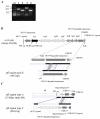The presence of the pilus locus is a clonal property among pneumococcal invasive isolates
- PMID: 18307767
- PMCID: PMC2270847
- DOI: 10.1186/1471-2180-8-41
The presence of the pilus locus is a clonal property among pneumococcal invasive isolates
Abstract
Background: Pili were recently recognized in Streptococcus pneumoniae and implicated in the virulence of this bacterium, which led to the proposal of using these antigens in a future pneumococcal vaccine. However, pili were found to be encoded by the rlrA islet that was not universally distributed in the species. We examined the distribution of the pilus islet, using the presence of the rlrA gene as a marker for the locus, among a collection of invasive isolates recovered in Portugal and analyzed its association with capsular serotypes, clusters defined by the pulsed-field gel electrophoretic profiles (PFGE) and multilocus sequence types.
Results: Only a minority of the isolates were positive for the presence of the rlrA gene (27%). There was a high correspondence between the serotype and the presence or absence of rlrA (Wallace coefficient, W = 0.778). In particular, there was an association between the presence of rlrA and the vaccine serotypes 4, 6B, 9V and 14 whereas the gene was significantly absent from other serotypes, namely 1, 7F, 8, 12B and 23F, a group that included a vaccine serotype (23F) and serotype 1 associated with enhanced invasiveness. Even within serotypes, there was variation in the presence of the pilus islet between PFGE clones and a higher Wallace coefficient (W = 0.939) indicates that carriage of the islet is a clonal property of pneumococci. Analysis of rlrA negative isolates revealed heterogeneity in the genomic region downstream of the rfl gene, the region where the islet is found in other isolates, compatible with recent loss of the islet in some lineages.
Conclusion: The pilus islet is present in a minority of pneumococcal isolates recovered from human invasive infections and is therefore not an essential virulence factor in these infections. Carriage of the pilus islet is a clonal property of pneumococci that may vary between isolates expressing the same serotype and loss and acquisition of the islet may be ongoing.
Figures


References
-
- Mora M, Bensi G, Capo S, Falugi F, Zingaretti C, Manetti AG, Maggi T, Taddei AR, Grandi G, Telford JL. Group A Streptococcus produce pilus-like structures containing protective antigens and Lancefield T antigens. Proc Natl Acad Sci U S A. 2005;102:15641–15646. doi: 10.1073/pnas.0507808102. - DOI - PMC - PubMed
-
- Barocchi MA, Ries J, Zogaj X, Hemsley C, Albiger B, Kanth A, Dahlberg S, Fernebro J, Moschioni M, Masignani V, Hultenby K, Taddei AR, Beiter K, Wartha F, von Euler A, Covacci A, Holden DW, Normark S, Rappuoli R, Henriques-Normark B. A pneumococcal pilus influences virulence and host inflammatory responses. Proc Natl Acad Sci U S A. 2006;103:2857–2862. doi: 10.1073/pnas.0511017103. - DOI - PMC - PubMed
Publication types
MeSH terms
Substances
LinkOut - more resources
Full Text Sources
Medical

